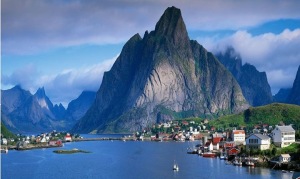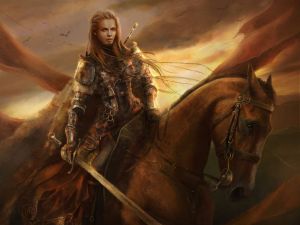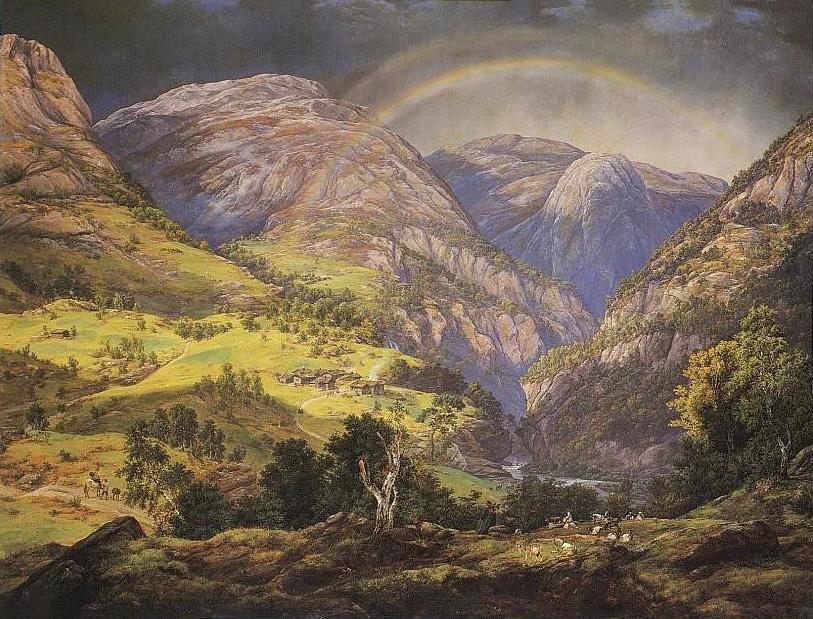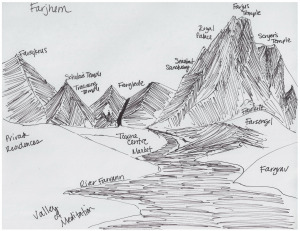Farjhem

Farjhem (Father's Home) is the sacred land of the Farværdig (also known as Empyreans).
Ancient texts tell us Father Emyr created all in this world billions of years ago. It took millions of years for cosmic and living forces to meld Earth into the idyllic Farjhem Emyr envisioned for his children. The precise location is known only to his Children, nestled between two glaciers in Northern Norwegian fjords. The River Farvann splits the land in half.
Nestled between two glaciers, in a fjord. The river Farvann flows through the center of the fjord, separating the two sides of Farjhem. Deus Ponte, God’s Bridge, is the only connection other than by ship. On the east side of the Farvann, the town square, the royal palace, the Senetat’s Sanctuary, and all important buildings. The east side is nestled into a hillside, with the palace near at the highest point, overlooking all of Farjhem. On the west side, the Scholars and the private homes of those Empyreans who have permission to remain in Farjhem. The west side is a valley, and holds the only entrance in and out of Farjhem, though the city can only be entered by an Empyrean or a Halfling.
Farjhem cannot be seen with the eyes of Man, only the eyes of Empyreans.
Farværdig Basics

As He created all the other creatures of the Earth, Emyr crafted two final species: Men and Empyrean. Men were created 200,000 years ago, in the blueprint of animals. Emyr rejoiced when he created His Children. Similar in appearance to Man, but gifted with power, intelligence, and great strength. Beyond the same Creator, Man and Empyrean share the same DNA, the key difference being there are genes dormant in Men which are active in the Farværdig. Those genes gift Empyreans long lives, and special capabilities. Perfect cell replication.
Early in their common history, the Farværdig mixed more freely with Man. The results were unpredictable. Sometimes gifted in magic, offspring of the inevitable mating filled the role of healer, or shaman, in their simple society. Other half-breeds were of great size and strength. Those are the giants of legend, veritable gods to the Norse and Viking Man colonies. The Ispolini of Bulgaria. Daityas of India. Empyreans traveled the globe, spreading knowledge and seed indiscriminately. Even the Christian Bible documents these children mixed of Man and Farværdig, Nephilim, as ‘sons of God, daughters of Men.’
Several thousand years ago, a group of power-thirsty Farværdig rose up, declaring a governing body was needed to regulate such events. Initially cloaking themselves in ideals of democracy, as later the Romans would with their Senate, most believed their intentions pure. Farværdig royalty had never served a purpose beyond their mark of distinction. Their desire was not to govern, but to enjoy the luxuries afforded their position.
This governing body became the Eldre Senetat.
Notable Structures and Areas
Scholar's Temple (includes the Great Library)
Senetat’s Sanctuary
Royal Palace (flanked by large gold phoenixes and red accents)
Blacksmith’s Shop (abandoned)
Farsykehus- Apothecary and Healers
Scryer (top of the hill, above the palace)
Market
Homes (for those allowed to remain in Farjhem)
Temple of the Grand Eldre Senetat
Valley of Meditation
Training Temple (adjacent to the Scholar’s Temple)
Farjus Temple (for worship of Emyr)
Farglede (Celebration Hall)
Town Centre (most events, celebrations start or end here)
Statue of slain Runa and Erikr
Statue of the Senetat and Royal Family, joined in unity
Fargengsel- The prison/torture structure.
Farskilt- fires/mines under the volcano. Used for long-term punishment.
Fargrav- Burial place for passed Empyreans.

Sensory
Sounds: Water can be heard everywhere, from the Farvann, to the waterfalls surrounding the glaciers of the fjord.
Smells: Crisp, clean air. Baking of bread.
Map (Hand-drawn by author)
As with all content on www.sarahmcradit.com, this page and contents are copyright Sarah M. Cradit, unless a source is otherwise specified. All rights reserved.
